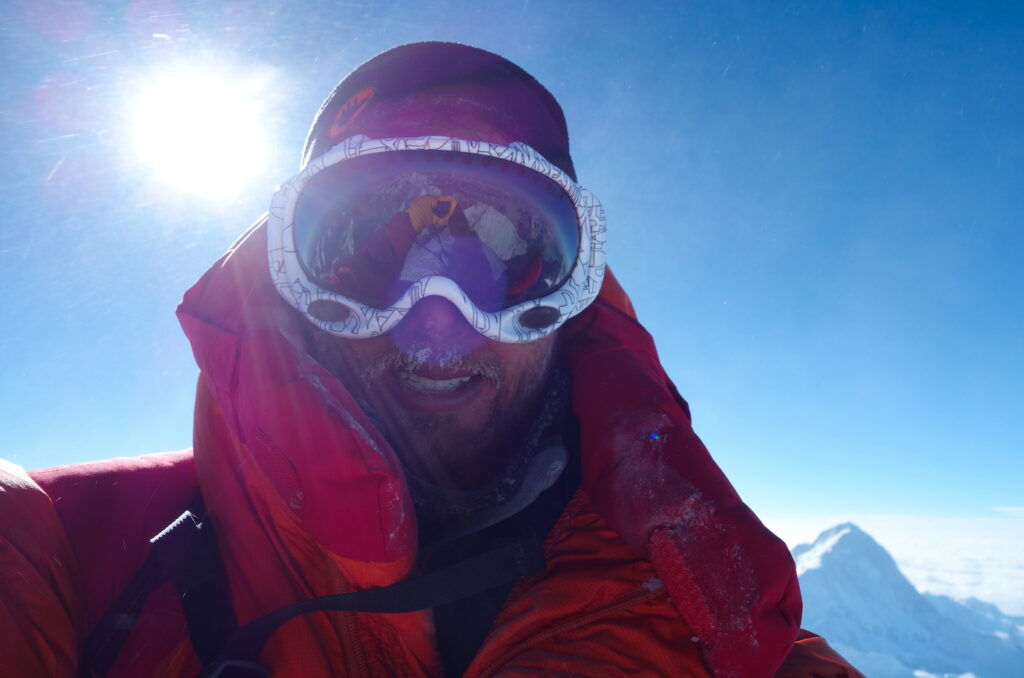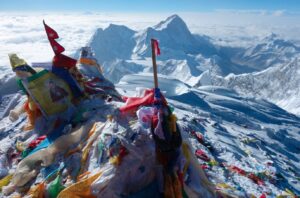If you had told me when I was a kid that I would one day climb Mount Everest, I would not have believed you. Even though I grew up in Colorado, and my family and I spent a lot of time hiking in the mountains, I never thought real alpine climbing would become a part of my life. I remember often staring at a postcard of Everest that some family friends, development workers in Nepal, had sent me when I was a kid, thinking how incredible it would be to climb that incredible peak. But the idea that I might actually climb it never crossed my mind. I was more motivated by academics than mountains, studying physics and international relations at Stanford University. Following college, I pursued a career, first investing in startup companies, and later public companies. I left venture capital in 2008 to move to New York City and work at a Warren Buffett–style investment firm. If the mountains were calling, I wasn’t answering more than a couple times a year, when I would go back to visit family and hike 14ers in Colorado.
My childhood fantasies didn’t begin to grow into a recognizable form until four years ago on Christmas Eve. My dad and I were up on Longs Peak in Rocky Mountain National Park on a hike. We hoped to summit but had been turned back on the Boulder Field by an impending storm. Now, I know what you’re thinking: family hike to a 14,000-foot summit in winter conditions on Christmas Day? Sounds like a family of serious alpine climbers. But, we really weren’t. I had a modicum of technical ability and was trying to drag my very strong dad up a fairly snow-free path.
On our descent we came upon a couple of serious-looking alpine climbers on their way up. Their packs were laden with ice axes and ropes, and they had a steady determination to their steps. I got the impression these guys had seen some storms in their day, and that this one wasn’t going to hinder them from their objective. I struck up a conversation with one of them and, after hearing that they planned to climb an ice and mixed route at the bottom of the famous Diamond on Longs, ventured to ask him if he’d ever climbed anything bigger. The guy chuckled and hesitated.
I would later learn that that climber—the famed alpinist Fabrizio Zangrilli—had spent years in the Himalaya, with some six attempts on K2. My chance encounter with Fabrizio sparked a new and exciting chain of events. We ended up exchanging information there by Chasm Lake, then went our separate ways.
As my dad drove us home that night, my mind was already turning. When I got back to New York, I called Fabrizio and asked if he thought it was too late in the year to begin training for a trip to the Himalaya to climb an 8,000-meter peak. I half-expected him to laugh, as I thought these trips took years to plan, but he didn’t. Instead, he told me it was possible.
Within a couple weeks I was back in Colorado to do a semi-technical 14er climb with Fabrizio to assess my conditioning and basic technical abilities. He felt I more than met the bar on physical fitness (I was a runner, and had recently run a 2:42 marathon), and the technical difficulty of our climb exceeded that of Everest’s standard routes, so he gave me the green light.
When I stepped on the plane back home in New York, I had never climbed higher than 14,000 feet. So going from there to the summit of Everest—the highest point on the planet—was (admittedly) crazy. But a few other events in my life with work just happened to conspire in the direction of undertaking the expedition around this time. So I went forward with cautious optimism, promising my parents that I would play it safe, and turn around if I didn’t have it in me.
On the evening of May 3, 2013, I arrived at Everest Base Camp on the Tibetan side. My boss had approved my extended vacation request, but for only five weeks rather than the seven or eight that most people take. Hence, by the time I got to Base Camp, my peers were already on their second rotation on the mountain, and the camp was mostly empty. I had rushed the overland journey from Kathmandu to Base Camp, so I was already feeling the altitude. That first sunset across the glacial valley, with its stark shadows and plunging temperatures, was breathlessly beautiful and surreal.
I had selected SummitClimb to support my climb, and they had proved wonderfully flexible with my need to come late. I ended up climbing with a personal Sherpa, because I planned to attempt Everest without oxygen and wanted someone knowledgeable and fit as a partner and a second set of eyes on my health. Given my inexperience at altitude I knew I might not be able to succeed without oxygen, especially on such a short timeline, but you don’t know unless you try.
Given the shortness of the time, my Sherpa, Lakpa Nuru, and I did one rotation up to Advanced Base Camp (ABC). After a few days there we took an acclimatization hike partway to the North Col. On the way back I developed a splitting headache and drank gallons of water back at ABC before it improved just enough to not require descent. That was the last headache I got. A few days later we slept at Camp 1 (North Col) and returned to ABC for a couple days’ rest before making a summit bid.
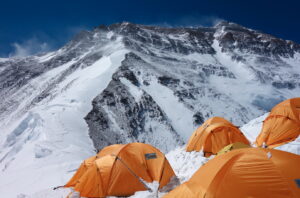
My running fitness had put in me in good stead up to this point, with reasonable times between camps, but as we got to Camp 2 at 7,500 meters, I started to really feel the altitude. I continued to hope that I would be able to do the climb without oxygen, and Lakpa and I made two attempts from the North Col. After the first night at Camp 2 I was utterly wasted, and after a couple hundred feet struggling up the rocky ridge toward Camp 3, I yelled to Lakpa, “I can’t do it!” We went back to the North Col and rested a few days before making our next and final bid.
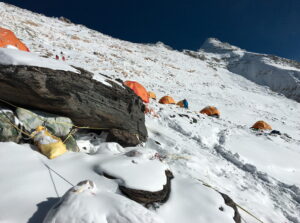
With a couple days’ rest I felt stronger, and we went for Camp 2 again. This time I woke up feeling alright, and we headed for Camp 3 at 8,300 meters. By the time we arrived in the afternoon on May 21, I was moving at a snail’s pace. Five steps forward, and then I’d count 50 breaths. I felt hypoxic but no headache. I was very dehydrated and thought that we’d arrive to pitched tents and would immediately be able to melt water. This was wishful thinking and I sat in the sun as a couple Sherpa pitched tents for us. As I sat there, my energy melting away, I began to wonder if it was safe to continue without oxygen. I spoke with a few other climbers and Sherpa who were all on O2, and decided to take their advice and go the safe route. I felt overwhelmed with disappointment, but also relief, when I put on the mask and fell into a pre-summit-bid nap.
That night, sometime after midnight, we set off with a long string of other climbers for the summit. With the benefit of oxygen I felt very strong, and Lakpa and I passed everyone in the queue by the time we made the ridge. The sun was rising just as we hit the summit pyramid. As we crested the summit ridge and the destination was finally in view, only a couple hundred meters away, I remember thinking to myself, “This is actually happening!”
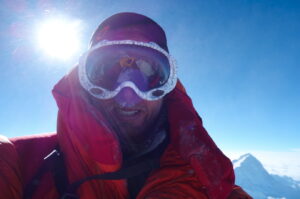
The summit was mostly empty, and the experience was pure magic. I dropped to my knees in gratitude and stared out across the hundreds of miles of glaciers, peaks, and plateaus, overwhelmed with the thought that I couldn’t go any higher by foot, anywhere. As my friend and fellow climber Mur Ashur put it, “on top you feel a bit like you’re on an antenna, and all the energy of the world is flowing up through you.”
The one missing piece from my climb for me was that I hadn’t done it by what I consider “fair means.” In using supplemental O2, I felt that I had lowered the mountain to meet my abilities, rather than rising, myself, to meet the mountain. I still didn’t know if I had what it took to climb all the way using only my own lungs and the air around me; but in that moment, right then and there, I knew that one day I wanted to return and try again.
-by David Roeske
David’s journey continues: Read how he trained for climbing Everest and Cho Oyu in one season without supplemental oxygen in “The Martian Trains for Everest.”

